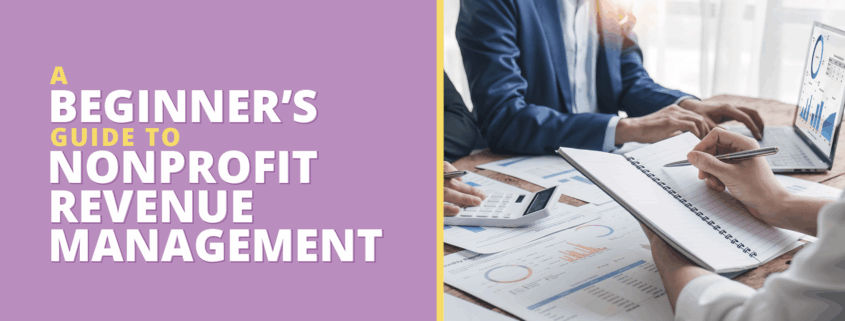A Beginner’s Guide to Nonprofit Revenue Management
Nonprofit revenue is rarely predictable. Donor behavior shifts, variable funding cycles, and economic pressures can make accurate planning feel impossible. But with the right revenue management strategies, your team can take control of your nonprofit’s resources and make more informed decisions.
In this guide, we’ll break down what nonprofit revenue management is, what its benefits are, and how your organization can implement successful strategies.
What is nonprofit revenue management (and why does it matter)?
Nonprofit revenue management is the process of actively monitoring, planning, and optimizing income to support both short- and long-term goals. Effective revenue management tracks not only how much money comes in, but also when cash flows occur and what types of revenue your nonprofit receives.
Revenue management aims to optimize your nonprofit’s income sources and timing to ensure financial sustainability and alignment with your goals, even if you face complex situations or challenges. Understanding when and how revenue will be available allows you to make informed decisions about launching new programs, hiring staff, or scaling operations, which in turn fosters greater trust with stakeholders and empowers your team to proactively manage challenges.
Top Revenue Management Tips
Understand and categorize your current revenue streams
Before you can manage revenue effectively, you need to understand where it comes from. Tracking your current revenue streams lays the groundwork for more accurate forecasting and budgeting, helping you allocate resources effectively.
- Identify all current sources of income: individual donations, grants, investment returns, corporate sponsorships, and earned income (e.g., membership fees or product sales).
- Categorize each by type, timing (recurring or one-time), and restrictions (unrestricted vs. restricted).
- Develop a reporting process that allows you to monitor revenue trends and understand how different streams perform over time.
There are a range of tools you can use to power your reporting process. Jitasa’s guide to nonprofit accounting explains that “while many organizations start out managing their finances in a spreadsheet, a specialized accounting platform will become necessary as your nonprofit grows.”
Remember to work with your finance team to ensure that revenue is classified accurately in your accounting system. Accurate categorization is essential not only for producing reliable financial reports but also for passing audits and maintaining transparency with your board and donors.
Diversify revenue for financial stability
After categorizing your organization’s revenue streams, you’ll be able to see what sources you’re relying on the most and what areas offer potential for growth. Use this information to take steps to create a more sustainable funding model through revenue diversification.
Try implementing one or more of the following programs to braid a new tactic into your revenue streams:
- Create a monthly giving program. These programs encourage donors to commit to a recurring gift each month. This revenue is predictable, typically unrestricted, and useful for long-term planning. Leverage it by identifying and reaching out to your most loyal supporters about joining, as well as offering easy sign-up options with suggested donation tiers.
- Tap into workplace giving opportunities. Employee matching gifts, volunteer grants, and charitable giving stipends are all examples of common corporate programs that encourage employees to give to nonprofits like yours. 360MatchPro’s guide to workplace giving strategies suggests you make the most of workplace giving opportunities by familiarizing yourself with businesses that have existing programs and building relationships with these companies by showing how your missions are aligned.
- Explore nontraditional donation types. Cash and credit aren’t your only options for accepting donations—many donors today appreciate the option to donate stock, donor-advised fund grants, or even cryptocurrency. Nonprofits that accept both asset and cash donations can increase individual contributions by 55%, so it’s worth it to set up a brokerage account or invest in a donation platform that makes these transfers easy.
Diversification reinforces your revenue management efforts by smoothing out cash flow and increasing resilience, ultimately allowing your team to plan with greater confidence and flexibility.
Implement a revenue forecasting process.
Forecasting helps you make informed decisions with greater agility, particularly when managing multiple, fluctuating revenue streams. It’s dynamic and relies on real-time data to project cash flow trends.
Here are some tips to get started with forecasting:
- Analyze your historical revenue patterns, including seasonality in donations and the timing of grant disbursements. Use this information to establish baselines for future expectations.
- Segment your forecasts by source to gain insight into how reliable and consistent each revenue stream may be. Factor in donor behavior such as giving frequency, average gift size, and retention rates to more accurately anticipate how your revenue streams will perform over time.
- Use technology like your CRM and accounting software to automate data collection and streamline forecasting. These tools can track pledges, recurring gifts, funding restrictions, and real-time donation activity, helping you adjust projections as new trends emerge.
A consistent forecasting process helps your team identify revenue gaps before they impact programs, optimize campaign timing, and build a more agile, resilient fundraising strategy.
Align fundraising and finance
Breaking down barriers between finance and fundraising aids with strategic decision-making and overall revenue management. These two functions may speak different “languages,” but their goals are the same: ensuring your organization has the funds it needs, when it needs them, to achieve its mission.
Ensure these areas work together by:
- Holding regular meetings between departments to review forecasts, budgets, and revenue reports.
- Working together to understand nonprofit revenue recognition, especially for large gifts, grants, or pledges.
- Using financial reports to inform campaign strategies—for example, if financial professionals anticipate a dip in available unrestricted funds mid-year, your fundraising team can plan a targeted donor appeal to bridge the gap.
- Encouraging fundraisers to use revenue insights to segment donors, pitch appropriate gift levels, and identify growth opportunities.
Collaborations between finance and fundraising teams help you use your revenue data to take strategic action. This ensures that budgets are grounded in real fundraising potential, that forecasts reflect operational needs, and that your revenue management strategy is accurate and adaptable.
Effective revenue management is essential for your nonprofit to be sustainable and impactful. When your team understands the full picture of where revenue comes from and how to make decisions that maximize your funding, you can plan for the future with more precision and purpose.




